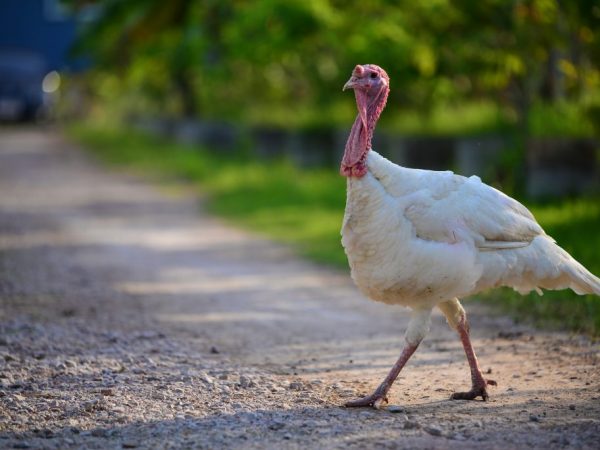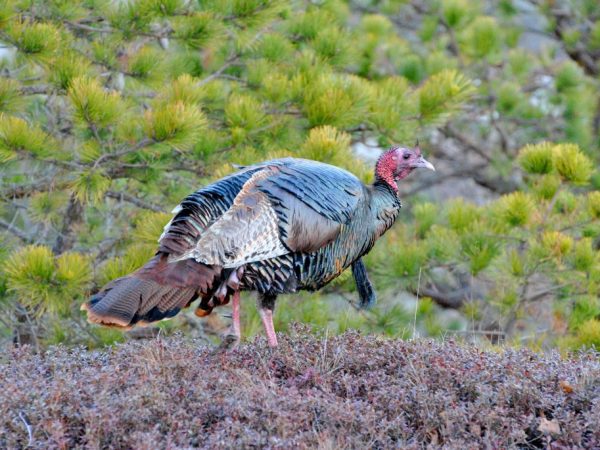Varieties of turkey crosses
Turkey crosses are often used for industrial structures. But today it is often found that small private farms acquire such hybrid breeds. Cross turkeys differ from others in that they gain weight very quickly and they have a fairly large body weight. It is thanks to this that many poultry farmers find it profitable to grow them, but at the same time spend a minimum amount of feed.

Varieties of turkey crosses
Cross - what is it
There are several types of turkey cross. Or rather three:
- heavy;
- middle;
- light.
They all have different origins. Some are from America, others from Western Europe, and some were grown on the territory of the Russian Federation. But today the best suppliers are considered - France, Germany, Great Britain, Hungary. In order to improve the productivity of turkeys, breeders distinguish several branches of distinctive characteristics. The main ones are a high percentage of bird weight, long vitality, and of course, egg production... Each future offspring must inherit all of the listed qualities. For this, breeders use several types of birds.
In order to get the best look, several breeds are crossed among themselves, which are considered the best of the entire breeding line. In all respects - the hybrid always surpasses its "parents" in the main characteristics. Scientists call this feature - heterosis. When several branches of different breeds are crossed with each other, the resulting breed first bears the name "combined".
But the connection of the branch, parents and hybrids with each other is just called - a cross of turkeys. In order to create a cross, two, three, or even four lines are used. Because of this, they get their name two-line, three-line, four-line. But by weight, they are divided into heavy, medium and light.
- Heavy Cross Turkeys is a Hybrid Converter, Big-6, Khidon.
- The middle cross is the Hybrid Converter, BIG-9.
- Easy cross - cross victoria, turkey cross wagon, Booth - 8.
Broad-chested white breed
This species does not belong to crosses, but it is thanks to it that many varieties have appeared today. The broad-breasted became the basis for the creation of various other breeds. Even the breed itself contains 3 other crosses. According to the crosses table, Victoria is the heaviest turkey. Wide-breasted was bred by a British company on the basis of other lines. Rumor has it that the white look was created from ten different lines. And they have the following characteristics:
- heavy - at thirteen weeks, their weight is five and a half kilograms, at twenty weeks, a turkey weighs twenty-five kilograms, and a turkey weighs eleven kilograms;
- average - at thirteen weeks, their weight is four kilograms, at twenty weeks they can reach twenty kilograms - these are turkeys, and turkeys - six to seven kilograms;
- light - thirteen weeks 3 and a half kilograms, at twenty weeks males gain eight to nine kilograms, and females - four and a half kilograms.
White broad-breasted grows up to the hundredth day of its life.They differ in that they have a high percentage of meat in terms of yield, always have an excellent presentation. The first time a bird leaves a clutch at nine months. Over the course of 6 months, they lay up to one hundred eggs, of which as much as 90 percent are fertilized. Of these, 70 percent is the withdrawal of babies. According to the reviews of poultry farmers, the breed itself is quite whimsical, does not tolerate low temperatures, in addition, it catches cold very easily. That is why, most often, this breed is bred in the south.
Wide-breasted White Hybrid
Hybrid species are considered popular crosses. It was the broad-breasted of this species that became the "reason" for the appearance of several breeds - fusion crosses. They first appeared in America. The main difference between birds is considered to be the excellent composition of meat, which includes proteins, but at the same time a small percentage of fat and cholesterol. Also, an important advantage of this species is that they grow very quickly and develop well. They adapt very well to completely different living conditions. The most famous hybrids of this species are:
- Hybrid Converter - refers to the heavy cross;
- Hybrid Grade Maker - refers to the medium cross.
Converter this cross reaches the bottomhole age - it is 145-155 days from birth. By this time, heavy turkeys are gaining weight of 24-25 kg, and females - 13 kg. In the world they are famous for their two main, positive qualities - a very fast growth rate and at the same time minimal costs for food. According to the reviews of many poultry farmers, the meat is very tasty and tender, and the carcass always has an excellent presentation. Growing up is not difficult.
Grade is an average type of bird, already at 123-133 days from birth, the male reaches 19-21 kg, and the female 11 kg. It is said to be best slaughtered at twelve weeks. Very often, a photo of a carcass can be seen on advertisements and various production brochures. But there is a small minus, at this moment the weight of the bird is no more than four kilograms, although it is during this period that the bird sent for slaughter.
BIG - 6

Large turkey
Big - 6 are heavy cross breed turkeys. This is a very popular and relevant species among avian industrialists. It is often found on small farms and large enterprises. This cross appeared due to the crossing of the BIG - 5 branch and the BUT - 8 cross. At the time of slaughter, males reach more than 23 kilograms, and females - eleven kilograms. The main thing is that the meat yield is over 80 percent, the cultivation is simple. Turkey poults are born white.
Birds grow very quickly, already at the age of three months their weight is 5 kilograms. It takes a little feed to feed, which is why the breed is beneficial for breeding. The plumage of these birds is always white, very tight to the body. The structure of the body is very strong and powerful, the body is oblong, the chest is very large and strong, almost 31 percent of the meat is in it. The tail is very lush and noticeable, the legs are powerful and long, rather widely spaced between each other, the head is medium in size.
BIG - 9
It also belongs to the variety of the white idea, it is distinguished by its good endurance and a large percentage of fertility. Within 6 months, one bird can lay more than 125 eggs. The percentage of hatching from clutches is 85. Similar to the percentage of hatching of the cross of Victoria. Turkeys of the BIG-9 cross are heavy. This makes them perfect for breeding, both for large industrial farms and for small ones. Birds gain their mass rather quickly, already at the seventeenth week their weight is seventeen kilograms.
At twenty weeks, the weight is 22 kilograms. Here females usually weigh two times less, but they grow faster. One of the positive qualities of this cross is that it does not require a lot of feed. Unlike Big - 6, this Big - 9 requires less feed. Big - 9 was the start for many new lines. Better to take a Canadian origin. The best crosses among whites.
BUT -8
The cross turkey is a relatively new type of turkey that belongs to white turkeys. This cross was created by British scientists, who also developed the two species described above. Booth-8 is a light species, a turkey at the age of seventeen weeks reaches a maximum weight of seventeen kilograms, and a female - 9 kilograms. Also, experts focus on the fact that the waste of feed on birds doubles with age. It is because of this that most farmers are advised to send turkey poults for slaughter at the age of 14 to 17 weeks, the converter is average.
Otherwise, because of this, you will spend a lot on feed, and even after the sale of carcasses, you will not be able to recoup the amount spent on feed. According to the external description and appearance, the carcass does not differ in any way from others. This type of converter is positive. Turkey feeding will not be a big hassle. The feathers are white in color and in structure, they are very dense without any dark spots. The body is elongated, strong, and the chest is well developed. The legs are very strong in structure and wide apart.
Turkeys have a very strong and expressive neck, there are also bright growths on the bird's head and a bushy tail stands out. You can see this view in more detail in the photo. It is because of this that most farmers give birth to this species for decorative purposes.
Station wagon
The wagon is the type of turkeys that was bred in Russia, belongs to the light type. Already at sixteen weeks, turkeys weigh six and a half kilograms, and females - four and a half kilograms. The species appeared due to selective crosses of two branches U1 and U2. Unfortunately, the station wagon gives hindquarters along with other foreign breeds. The main factors behind the species are:
- weight gain;
- egg production.
But there are also positive aspects - this is a long life expectancy and unpretentiousness in nutrition. They lay poorly - they can produce only 65 to 75 eggs per year.
Khidon
This species is a difficult species, it was bred in the Netherlands. Adult males are slaughtered at a weight of twenty kilograms. You need a little feed, the breed itself is not whimsical and has a good weight gain. In feeding, they are not whimsical.
In one year, they will lay from 90 to 110 eggs. But one more minute apart from low egg production is difficult growing and breeding. Kids are very afraid of dampness, drafts and sudden changes in temperature. Also for such a breed a convector is needed. It is not recommended to grow at home. White turkeys come in a wide variety of varieties. From the many lines of white birds, new crosses are created that amaze with their qualities.


